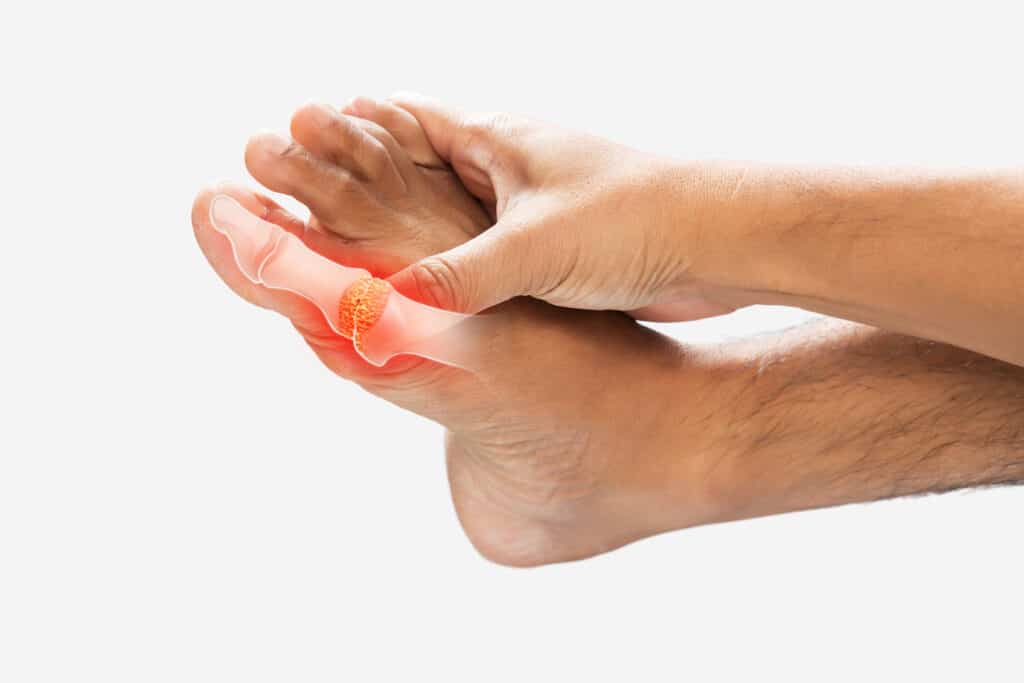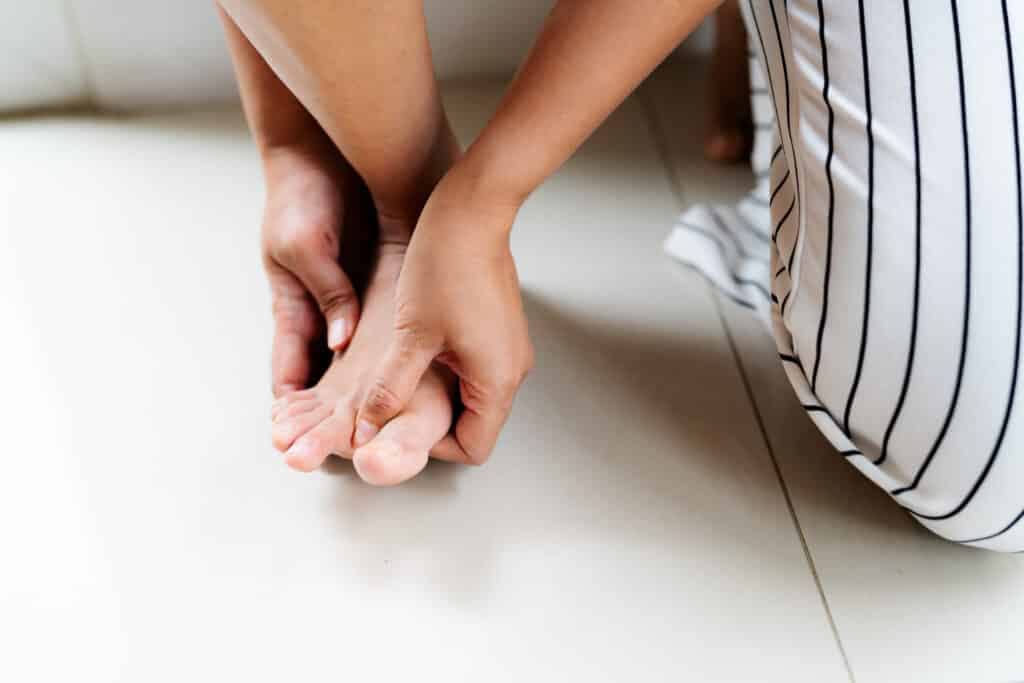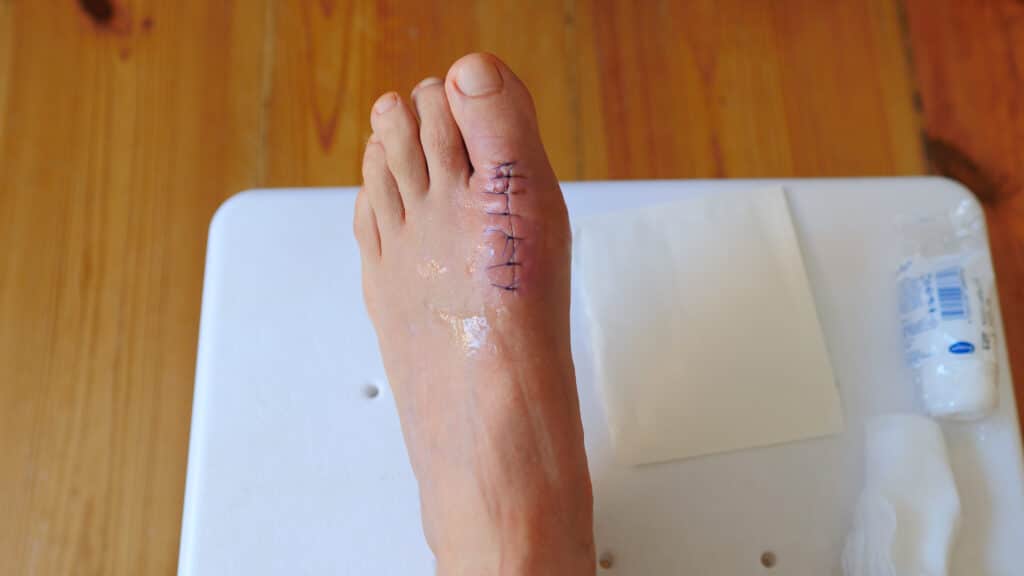Hallux Rigidus: A Stiff MTP Joint
Your toes are an easy thing to take for granted. But if you’re affected by a condition called hallux rigidus, you realize just how big a role these small digits play in your life.
Hallux rigidus is the medical name for a stiff big toe or big toe arthritis. The word hallux refers to your big toe, while rigidus indicates rigidity and immobility. Hallux rigidus is the most common type of foot arthritis, and it can make walking and enjoying your favorite activities painful.
Big Toe Anatomy: The Metatarsophalangeal (MTP) Joint

The joint at the base of the big toe is called the metatarsophalangeal (MTP) joint. This joint supports about 40 percent of your body weight each time you take a step. It helps your big toe get a good grip and enables you to maintain your balance when walking.
The ends of the MTP joint are covered in a type of smooth cartilage called articular cartilage. If this cartilage gets damaged, the joint space can narrow, and a bone spur (osteophyte) may form. This overgrown bone can make it hard to bend the toe when walking or during exercise.
Most cases of hallux rigidus develop on their own over time without any obvious cause. It’s most common in adults between 30 and 60. You are also more likely to develop hallux rigidus if you are a woman, an athlete, or spend all day on your feet.
Common causes of hallux rigidus include:
- Wear and tear (hallux rigidus is a type of degenerative osteoarthritis)
- Overuse of the MTP joint caused by a recreational activity or job
- Traumatic injury, such as stubbing your toe or turf toe
- Poor foot alignment, such as a bunion, excessive pronation, or flatfoot/fallen arches
- Longer than usual foot or toe bones
- Genetic factors
- Preexisting conditions like rheumatoid arthritis, gout, certain autoimmune disorders, or osteochondritis dissecans
Early signs of Hallux rigidus are pain and stiffness in the big toe joint. Other symptoms of the condition can vary, but the most common ones include:

- Pain in and around your big toe when walking, standing, or squatting
- Joint pain on top of the joint or deep inside it
- Stiffness in the big toe or an inability to bend it up and down
- Swelling or redness around the big toe joint
- A bump that looks a bit like a bunion on the top of the foot
- Difficulty with high-impact activities like running or jumping
- Discomfort wearing narrow shoes, including rubbing on top of the foot
- A tendency to walk with more weight on the pinky-toe side to avoid putting pressure on the big toe
- Dull pain in the hips, knee, or lower back
- Limping
If you have any of the above symptoms, see your podiatrist or orthopedic foot and ankle specialist for a diagnosis. They will:
- Perform a physical exam to check range of motion and look for evidence of bone spurs
- Take an X-ray of your foot to look for bone spurs, cartilage loss, and the degree of arthritis in the joint space
Hallux Rigidus Treatment
Hallux rigidus can be treated more easily early in its development when it is still considered hallux limitus rigidus. If you wait to see your orthopedic specialist for treatment until there’s already a bony bump on the top of your foot, bone spurs have likely already formed. The joint may already be arthritic, which can complicate treatment.
Nonsurgical treatment options for hallux rigidus include:
Ice. To help with pain and swelling, apply wrapped ice packs to your toe in 20- to 30-minute increments.
Contrast temperature therapy. Switch back and forth between placing your foot in a hot water bath and an ice water bath in 30-second increments for up to 5 minutes. This can help with pain and inflammation.
Changing shoes. Avoid wearing narrow shoes and high heels. Hallux rigidus shoes should have a large toe box to relieve pressure on the toe. Shoes with stiff, curved soles may also be more comfortable, or you can add an insert to regular shoes. Extra footbed support can reduce the amount of bend in the big toe, which helps with pain and inflammation.
Limiting toe movement. You may be able to insert over-the-counter foot pads into your shoes for hallux rigidus to give your big toe more support while limiting its movement. You may want to avoid stress-inducing physical activities like running or certain sports.
Pain relievers. Nonsteroidal anti-inflammatory medications like aspirin or ibuprofen can temporarily reduce pain and swelling.
Corticosteroid injections. Corticosteroid injections into the MTP joint can reduce pain if the above methods have not been sufficiently helpful and you do not want surgery. While these injections aren’t a cure, they can help relieve the pain.
If the condition is mild to moderate, you can also try hallux rigidus exercises. For example, grab your big toe and pull it back and up to its limit. Hold it in this position for about 20 seconds and repeat several times daily.
Hallux Rigidus Surgery

Most people do not need surgery for hallux rigidus. However, osteoarthritis surgery may be right for you if other treatments don’t help and it’s hard to enjoy your normal activities.
Some of the most common surgical treatments for hallux rigidus include:
Cheilectomy (bone spur removal). This procedure is best if your condition is mild to moderate. Your orthopedic foot surgeon will remove any bone spurs that have formed and may also remove a portion of the big toe bone so the toe has more room to bend.
Arthrodesis (joint fusion). This procedure fuses the bones of the toe together, and it’s better suited to moderate to severe hallux rigidus. In arthrodesis, your surgeon will remove any damaged cartilage, then use pins, screws, or a plate to place the joint in a permanent position. Over time, the bones will grow together, and you will not be able to bend your toe at all. This procedure is the best option for reducing pain in severe cases or cases where the cheilectomy does not remedy the issue.
Arthroplasty. Also called joint replacement surgery, arthroplasty may be best if you are older and have fewer functional demands on your feet. In this procedure, your surgeon will remove the MTP joint and replace it with an artificial one. This should relieve the pain and allow you to bend your toe.
If you have foot or toe pain and would like to speak with a specialist, please contact us or comment below.
Leave a Reply